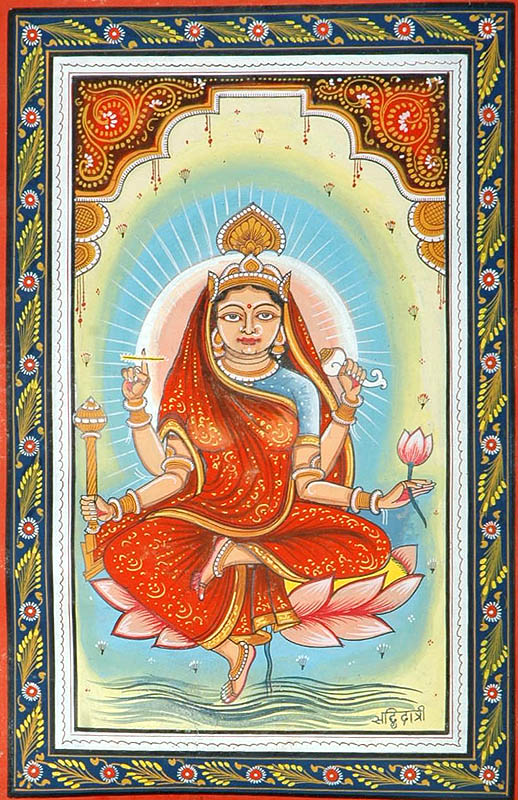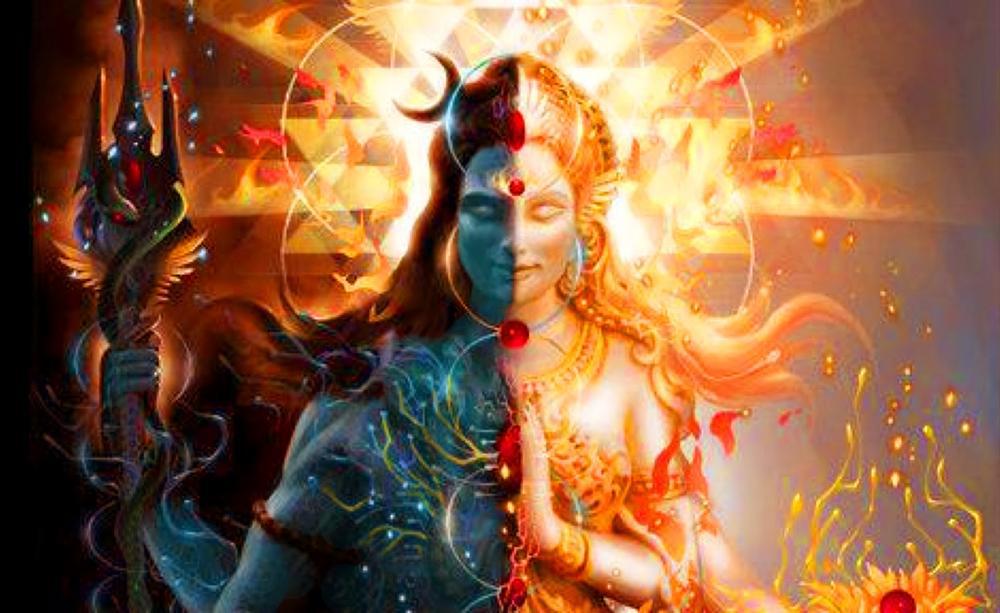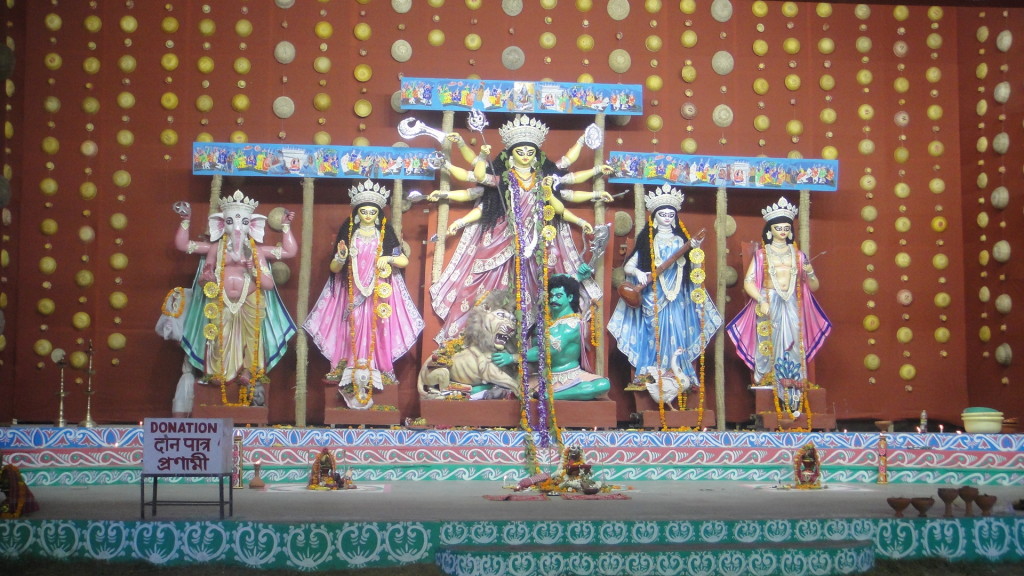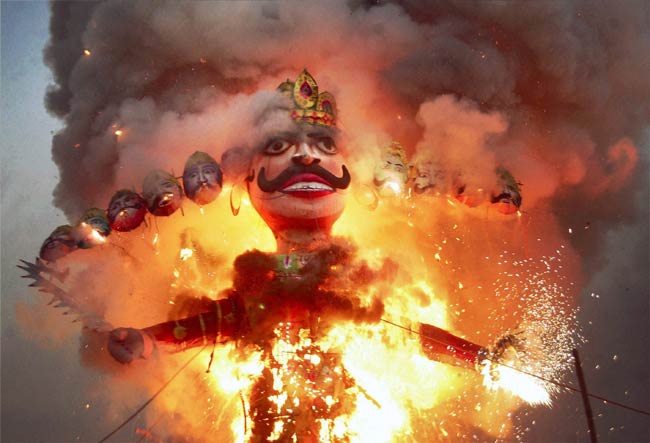
Navratri Day 9 | Worshipping Goddess Siddhidatri
Goddess Siddhidatri, the ninth form of Goddess Durga, is worshiped on the ninth day or the Mahanavami. This Goddess can be seen surrounded and worshiped by men, demons, Gods and yakshas (celestial beings). She is the giver of all siddhis (perfection) and ready to bestow happiness on her followers.

Goddess Siddhidatri. (Image: Exoticindiaart.com)
Origin and History
It is believed that one side of Lord Shiva’s body is that of Goddess Siddhidatri. Therefore, he is also known by the name of Ardhanarishwar. According to Vedic scriptures, Lord Shiva attained all the siddhis by worshiping this Goddess.
According to Hindu Shastras like Markand Puranas, this Goddess helps devotees in attaining perfection in Mahima, Garima, Ladhima, Prapti, Prakaamya, Ishitya and Vashitva. According to Brahmavaivart Purana, the Devi can bestow 18 different types of siddhis or perfections. These siddhis are Mahima, Garima, Ladhima, Prapti, Prakaamya, Ishitva and Vashitva sarvakaamaal, Saadhita, Sarvagynatva, Amaratva, Sarvanyayakatva, Bhavana and Siddhi. Worshiping Maa Siddhidatri wholeheartedly heart helps devotees attain perfection along with happiness and purity of heart.

The Ardhanarishwar avatar of Lord Shiva. (Image: 3.bp.blogspot.com)
Form and Appearance of Goddess Siddhidatri
This four-armed avatar of Devi Siddhidatri clad in a red saree is seen sitting on a lotus flower. She is also seen mounted on a lion. She is depicted holding a Gada (mace) in her upper right hand, a chakra in her lower right hand, a lotus flower in her lower left hand and a conch-shell in her upper left hand. It is said that one can even see a disc of light around her golden crown. This light is believed to instill devotion in the heart of devotees towards the Supreme Power and liberation from karmic bindings. Goddess Siddhidatri bestows occult powers on her worshipers and is therefore revered by beings from all three realms i.e. heaven, hell and earth.
Customs and Rituals
On the ninth day of Navratri, devotees bathe themselves early morning and worship the ‘Navratri Kalash’. All the chapters of ‘Durga Saptashi’ are recited and Mahanavami fast is observed. The devotees please the Goddess by performing puja, hawan and chanting Siddhidatri Pujanmantras. Devotees offer her nine oranges, burn incense, light earthen lamp, offer fragrant flowers, fruits, gems and clothing as a part of the puja ritual.
- The Mantra
Siddh Gandharv Yagyadhair Surair Marairapi
Sevyamana Sada Bhooyaat Siddhida Siddhi Dayanee.
Meaning: “The ways in which all the gods, goddess and divine souls worship you, in the same manner we worship you. Kindly grant your blessings on us.”
- Kanya Puja
Some devotees perform Kanya pujan on this day instead of Ashtami (eighth day). Devotees invite nine young girls to their house and worship them. These girls represent the Navdurga or the nine avatars of Goddess Durga. Devotees ensure that these colorfully dressed girls are seated on pedestals and offer them black chana, puris and halwa. As a part of the ritual, they also present them with money and clothes. They apply tikas and touch their feet to seek their blessings before bidding farewell to them.
- Durga Puja- The most celebrated annual festival in West Bengal
In the state of West Bengal, devotees worship and immerse beautifully decorated idols of Goddess Durga in rivers and sea. This ritual is basically known as Durga Visarjan. Processions of devotees carrying idols of Maa Durga on their heads bid farewell to this deity on this day. They believe that this Goddess will certainly vanquish all their troubles.

A Durga Puja Pandal. (Image: Timescity.com)
Mahanavami is Followed by Dussehra
Mahanavami or ninth day of Navratri precedes Dusshera. The tenth day or Dashmi, popularly known as Vijaydashmi symbolizes the victory of good over evil. People celebrate this festival by burning down the effigies of Ravana along with his brothers Kumbhkaran and Meghnad.

Dussehra celebrations. (Image: Indiatoday.in)
How to Look Ethnic and Trendy this Mahanavmi
Devotees prefer wearing sky blue colored attires on Mahanavami as it is considered quite auspicious. Accessorizing the ethnic wear with chunky pieces of jewelry and contemporary or traditional footwear will give a dashing appearance to your look.
For Women
- Lehenga: Accessorize your sky blue lehenga with a chic hair-do and dangling earrings in silver. Also, silver finished bangles will add a spark to the ethnic look. Complement the elegant attire with a nice pair of stilettos or wedge heels to add height to your stature.
- Anaarkali: Look beautiful in this sky blue colored Anarkali kurta. Team it up with matching leggings or payjama and ethnic belle shoes to create a stylish traditional look. You may also opt for gold ornaments and maang-tika in the mid-parting of your hair to complete the look.
For Men
- Kurta Payjama: Silk kurta payjama is a favorite ethnic wear this season. Blend the color of the kurta with a contrasting churidar for a different look. The look can be completed by wearing a pair of matching jooti embellished with colorful sequins and thread-work.
- Sherwani: This stylish but traditional outfit adds charm to your appearance. The embroidered borders in contrasting color will enhance the royal look of the attire. A slick pant or churidar will bring compliments your way. Team it up with a pair of beautiful jootis to complete the look.
Interesting Facts
- Maa Siddhidatri gives 18 types of siddhis to her saadhakas.
- Lord Shiva, also known as Ardhnareshwar, is believed to have attained all siddhis by worshiping Goddess Siddhidatri.
- Maa Siddhidatri has its shrine on the Mount Nanda in Himalayas, which is also a famous pilgrimage centre.
- Goddess Siddhidatri governs and also provides direction to the planet Ketu which is known as Dragon Tail in English.
Categories: Festivals
